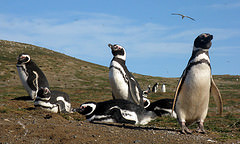Everyone on Chile’s Isla Magdalena looks just about the same. Black is in, white is in, and horizontal stripes are considered OK. The treeless, grassy island, located in the Strait of Magellan off the coast of Punta Arenas, is home to about 150,000 Magellanic penguins for a few months every year.

I spent a recent afternoon wandering the island, coming within several feet of many of its inhabitants, who seemed to carry on with their usual activities despite my presence. These consisted mainly of:
1. Grooming (very important)
2. Sitting/lying (secondarily important)
3. Walking in lines (a third priority)
And now, for some fun Magellanic penguin facts: • Magellanic penguins eat the cuttlefish, sardines, squid, krill and other crustaceans they find in the water. They rely on a salt-excreting gland to filter the salt out of their food. They do without pepper as well. • The species of penguin gathers in large colonies off the coast of Chile and Argentina every summer to nest and breed. The men arrive early and await their women, who manage to recognize them by call alone (and perhaps, too, by that special twinkle). • The penguin couples lay two eggs at a time and usually end up raising one or both to adulthood. Parents take 10- to 15- day shifts watching over their eggs during the almost two-month incubation period. After the babies are born, the proud mother and father feed them every two to three days. • Magallenic penguins live an average of 25 years in the wild. • They have been assigned a “near threatened” status, though millions live off the coast of Chile, Argenitina and Brazil. Oil spills, declining fish populations and the hungry mouths of predators like sea lions and giant petrels have made breeding extra important.
To get to Isla Magdalena, you sign up with a tour agency in Punta Arenas, lay down $64, catch a 7 a.m. or 5 p.m. shuttle to the “Tres Puentes” port outside the city and ride a zodiac 35 minutes across the strait. Once you reach your destination, you’re set free for a couple hours to stroll the path that circles the island.
On the way home from the colony, we made a pit stop at Isla Marta, home to about 1,000 sea lions that visit their neighboring island every day around lunch time. Our guide explained that the lions were lying on the beach in three basic piles: males, females and rejects. It reminded me of middle school.



